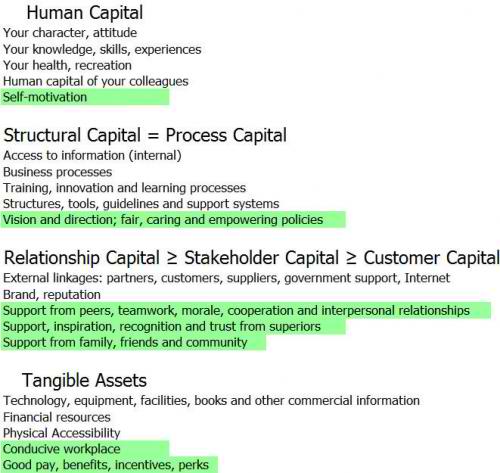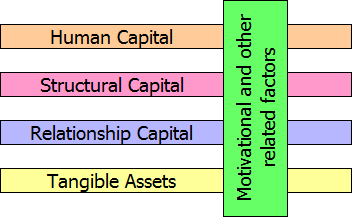Knowledge management (KM) cannot and should not focus on cognitive factors alone. A "Head and Heart Approach" is needed.
Effective Team Performance
The first cause of common confusion in the field of KM stems from the use of the very common word “knowledge.” Let us discern how leading KM practitioners use this word, starting with the guru of all management gurus, Peter Drucker:
“Knowledge is information that changes something or somebody – either by becoming grounds for action, or by making an individual (or an institution) capable of different or more effective action.” – Drucker
[Knowledge is] “justified belief that increases an entity’s capacity for effective action.” – Nonaka
“I define knowledge as a capacity to act.” – Sveiby
“Knowledge is information in action.” – O’Dell and Grayson
“Knowledge... should be evaluated by the decisions or actions to which it leads.” – Davenport and Prusak
“Knowledge is the understanding of relations and causalities, and is therefore essential in making operations effective, building business process, or predicting the outcomes of business models.” – McKinsey & Company
Thus, among KM practitioners, the term knowledge means capacity for effective action, which includes information, belief and understanding of causalities that are useful for effective action. Thus, information that is not actionable is not knowledge. Knowledge encompasses whatever helps a knowledge worker or a team do its job well.
Research Evidence
73 participants from different organizations were asked a question pertaining to effective action: "what helps your team do its job well?" 850 answers are shown in Figure 1. After clustering and studying the results of this simple workshop exercise, it can be observed that:
- There are three components of intellectual capital, namely, human, structural (some KM practitioners call this “process capital”) and relationship capital (some KM practitioners use the term “stakeholder capital,” while others use the more limited term “customer capital”);
- Intellectual capital is mostly intangible (accountants are hardly measuring this);
- Both tangible and especially intangible assets contribute to individual and ultimately to organizational performance;
- KM is directly linked to performance or value creation; an improvement in performance is the result of good KM and a basis for measuring KM impact;
- Other management disciplines overlap with KM (HR is about managing human capital; ICT is about managing part of structural capital; and CRM or customer relations management is about managing part of relationship capital, which is linked to social capital).
Figure 1. The Four Clusters that Consistently Emerge

Note: Sub-clusters highlighted in green constitute a fifth cluster that cuts across the four clusters. This fifth cluster consists of affective factors, not cognitive factors.
The above results reveal other, non-cognitive elements that affect performance:
- Relationship capital includes entries pertaining to relationships within the organization (or internal “social capital”) as well as outside the organization (the usual meaning of the KM term stakeholder capital). Intellectual capital management and common KM practice cover the management only of stakeholder capital (e.g., brand, customer relationships, etc.) but usually not the management of relationships within the organization.
- Human capital is not only about skills or expertise; it also covers character, attitude, health and self-motivation.
- Some sub-clusters (those highlighted in green) are actually more affective or attitudinal than cognitive or intellectual factors; they are more about motivational or energy factors than about knowledge factors, including both intra-personal and inter-personal factors. Yet, they seem to be a pervasive (cutting across the four clusters) factor that affects overall work performance. Clearly, “willing-to” or “wanting-to” is as important as “knowing-how” in enhancing work performance.
- The descriptive word “intellectual” in the term intellectual capital therefore fails to encompass all the intangible factors that contribute to more effective action or work performance.
- About 90% of the answers fall along the intangible assets category. This confirms the observation that value creation has become more dependent on the quantity and quality of intangible assets than on the tangible assets themselves. This is consistent with the common observation that in the knowledge economy market values of many corporations far exceed their book value.
- Motivational and related factors cut across all the four clusters (see Figure 2) and account for 44% of the answers; this cluster is a very important one. Managing knowledge must therefore be accompanied by managing motivational factors. KM practitioners have known from experience that incentives (material as well as non-material) are often necessary to make KM programs work. For this reason, “buy-in” has become part of the KM language. This is also why KM consultants hesitate to come into an organization or company without executive sponsorship or a KM champion from within the executive ranks. KM practitioners also note that knowledge sharing suffers if interpersonal trust is absent. Even the term “motivational factor” appears inadequate. Therefore, a more appropriately encompassing management model is a mix of knowledge management and management of “energy.”
Motivational Factors Intersect with Knowledge Assets

To encompass all factors which contribute to work and organizational performance (both aims to create value), the words intellectual and knowledge are not adequate. Managing only knowledge is not enough; it must be accompanied by managing motivational or energy factors.
